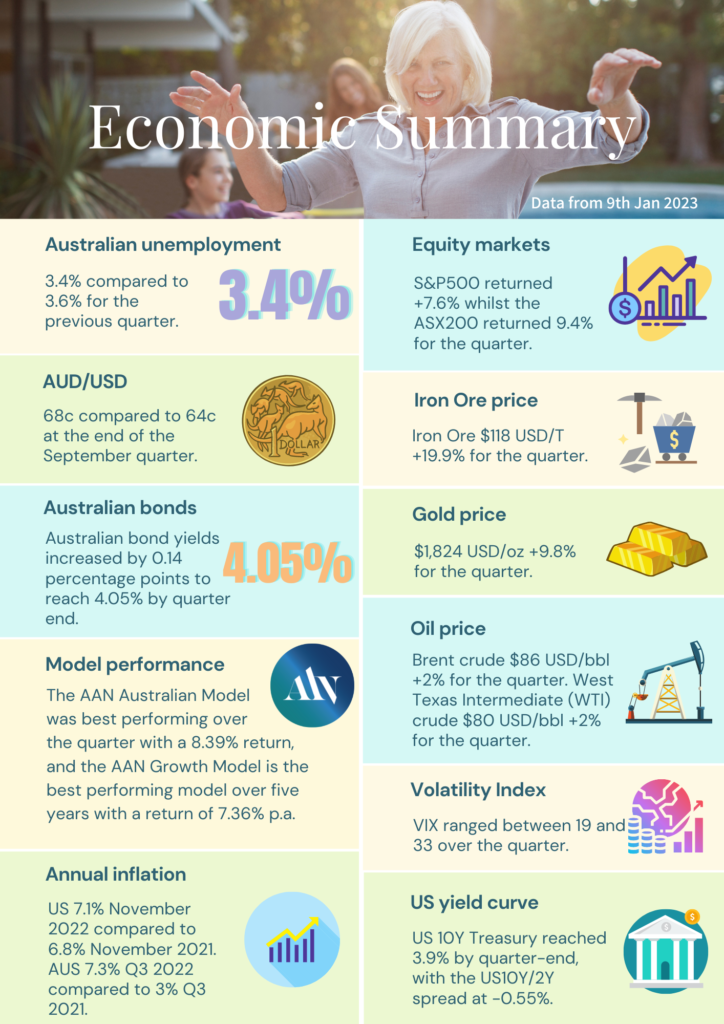Schedule a Chat
Contact Info
Suite 17.03, Level 17
20 Bond Street
Sydney NSW 2000

INSIGHTS WITH EVALESCO
TOPICS DISCUSSED
The December quarter saw a weaker USD (-5.5% against the AUD), lower unemployment in Australia, higher commodity prices, higher inflation rates in Australia (and incredibly high compared to a year earlier), a positive quarter for equity markets but volatile, higher Australian 10-year government bond yields, and an inversion of the US 2Y-10Y bond yield spread.
Significant events during the last quarter of 2022:
Looking at 2022 as a whole, it was one for the ages across the economic and investment environment. Etta James describes what some investors may have been feeling in 2022:
Life is bad
Gloom and misery everywhere
Stormy weather, stormy weather
And I just can’t get my poor self together
Oh, I’m weary all of the time
The time, so weary all of the time
Capital preservation through 2022 was incredibly difficult for diversified investors. There weren’t many places to hide. Of the twelve asset class returns shown in Figure 1, only commodities and cash were positive in 2022. This was the first time in about 150 years that there was a simultaneous double-digit fall in both bond and equity markets.

Figure 1: Calendar year returns for various asset classes
Source: FE Analytics
The almost forgotten phenomenon of inflation was the dominant theme and driver of markets through 2022. Annual inflation in Australia reached 7.3% by the end of September, compared to 3% a year earlier. More than double! In the US, headline inflation reached 9.1% mid-year before subsiding to 6.5% by December. UK inflation peaked at 11.1% in October but was down to 10.7% by November. Inflation in the Euro area also peaked in October, reaching 10.6%, before preliminary data showed it falling to 9.2% by December.
Global inflation was exacerbated by the Russian invasion of Ukraine in February. The negative impact to commodities and supply chains flowed through to energy and food prices. This was on the back of already strained supply chains after Covid shutdowns through 2020 and 2021. The response from central banks saw the fastest increase in rates in decades. Figure 2 compares central banks rates to a year earlier, with China being the clear outlier.

Figure 2: Central bank rates December 2021 versus December 2022
Source: Research IP, FE Analytics
Ten-year government bond yields soared accordingly on the back of elevated inflation figures. Figure 3 shows the magnitude of the yield increases, with all 10-year yields higher by at least 2-3 times compared to a year earlier.

Figure 3: 10-year government bond yields, December 2021 versus December 2022
Source: Research IP, FE Analytics
The rise in yields had a devastating effect on risk assets, particularly those with longer dated cash flows (see NASDAQ returns in Figure 1, down over 32% for the year). How did those FAANG stocks go? Meta (Facebook) -64%, Amazon -50%, Apple -27%, Netflix -51%, and Alphabet (Google) -39%. A surge in correlation between bonds and equities meant that many portfolios didn’t reap the benefits of diversification.
To summarise the outlook for 2023 in one sentence; global economies and financial markets are walking a tightrope. The most important risk will be the actual path of inflation and the response from central banks. The main question is whether central banks can increase interest rates to a point that will cool down the economy and lower consumer expenditure, whilst at the same time limiting job losses.
The US Fed is forecasting more hikes for 2023 (which is also a broader theme for other developed markets), though in smaller increments compared to last year. Inflation is forecast to fall but it is likely to stay above the target range, meaning tight monetary policy should persist through the year. History suggests that once inflation moves above 5% it can take several years to move back to 2%. Contrary to this, futures markets are pricing in cuts to the Fed funds rate. This suggests the damage to economic growth will become more apparent through the year, consequently forcing central banks to ease off the rate hikes.
A recession is on the cards in the US, though markets are not totally convinced with some expecting ‘subpar’ economic growth rather than a definite decline in growth. Europe has a higher chance of a recession due to the ongoing concerns around energy and food security. Australia and other economies around the globe are not immune, though China has the potential to provide a source of growth if the re-opening of their economy goes smoothly.
A cautious investment approach is recommended. Diversity of expert opinion and a broad overview of the global environment will be necessary to navigate the risks this year.
The following is a list of key risks (not exhaustive and not all mutually exclusive) to keep an eye on through 2023:
Today’s problem is inflation. Tomorrow’s problem is an economic slowdown. Nina Simone sang it in the 60s (or the Animals if you’re an Eric Burdon fan), and central bankers will be preaching it in the 2023:
I’m just a soul whose intentions are good
Oh Lord, please don’t let me be misunderstood

You can download the entire Quarterly Investment Update HERE
Regards,
Marshall Brentnall, and the AAN Investment Committee
SHARE OUR INSIGHTS
Share on Facebook
Share on Email
Share on Linkedin

NEWSLETTER

Evalesco Financial Services Level 17, 20 Bond Street Sydney NSW 2000
Phone: (02) 9232 6800
The information provided on and made available through this website does not constitute financial product advice. The information is of a general nature only and does not take into account your individual objectives, financial situation or needs. It should not be used, relied upon, or treated as a substitute for specific professional advice. We recommend that you obtain your own independent professional advice before making any decision in relation to your particular requirements or circumstances. Evalesco Financial Services do not warrant the accuracy, completeness or currency of the information provided on and made available through this website. Past performance of any product discussed on this website is not indicative of future performance. Copyright © 2019 Evalesco Financial Services. All rights reserved